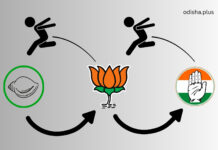By Prof Ujjwal K Chowdhury
 RBI Reserves Controversy Today:
RBI Reserves Controversy Today:
The Central Board of the Reserve Bank of India (RBI) today decided to transfer a sum of ₹1,76,051 crore to the Government of India (Government) comprising of ₹1,23,414 crore of surplus for the year 2018-19 and ₹52,637 crore of excess provisions identified as per the revised Economic Capital Framework (ECF) adopted at the meeting of the Central Board today. It may be recalled that the RBI, in consultation with the Government of India, had constituted an Expert Committee to Review the Extant Economic Capital Framework of the Reserve Bank of India (Chairman: Dr. Bimal Jalan). The Committee has since submitted its report to the Governor of the RBI. The Committee’s recommendations were based on the consideration of the role of central banks’ financial resilience, cross-country practices, statutory provisions and the impact of the RBI’s public policy mandate and operating environment on its balance sheet and the risks involved. RBI in its statement noted, “The Committee’s recommendations were guided by the fact that the RBI forms the primary bulwark for monetary, financial and external stability. Hence, the resilience of the RBI needs to be commensurate with its public policy objectives and must be maintained above the level of peer central banks as would be expected of a central bank of one of the fastest growing large economies of the world.”
This is the highest transfer of funds from RBI to the government, and more than three times of the amount transferred in 2018. This is to note that the current government since 2014 has already transferred a total of Rs.2.6 lacs crores from the RBI for funding government projects.
If the RBI agrees its reserves are in excess or adequate, the government can gain in two ways. If the RBI does not set aside more in funds, the government going ahead will get more from RBI every year as dividend. In case RBI liquidates reserves deemed excess, the current government gets one-time big cash inflow from the RBI as it sells some of its assets. However, the legality of this liquidation is not clear yet. This is where the controversy is.
The opposition and a few scholars opine that taking such a large chunk as Rs.1.76 lacs crores or $24 billion from RBI by the government is a sure sign of bankruptcy in the government and a huge fiscal deficit that it cannot handle. In fact, it is larger than the largest central bank (of USA) largesse to US federal government, i.e. $19 billion, last year from its surplus capital to finance transportation projects. It must also be noted that former RBI Governors Raghuram Rajan and Urjit Patel resisted such transfers of reserves to the current government, and left their positions under a cloud, after which current RBI Government Shaktipada Das took over.
Why Needed Not Explained Yet
The additional amount of ₹86,000 crore that the government will receive this year above its budgeted ₹90,000 crore as transfers from RBI could be either used to provide fiscal stimulus to a sagging economy, reduce off-balance sheet borrowings or meet the expected shortfall in revenue collections. However, the Finance Minister Nirmala Sitharaman has refused to divulge any details and that is a point of suspicion as this money may lead to inflation as well if not spent with caution.
 RBI Role & Functions:
RBI Role & Functions:
Section 22 of the Reserve Bank of India Act gives the Bank the sole right to issue bank notes as also the currency notes of the Government of India which may be supplied to it by the Government. Every scheduled bank is required to keep with the Reserve Bank a cash balance of not less than 3 percent of its total demand and time liabilities. The Reserve Bank has the power to increase the cash reserves up to 15% of the total demand and time liabilities. Hence, RBI is the bankers’ bank and lender of the last resort. The Reserve Bank of India acts as the banker to the Government, Central as well as States: receives and makes payment on behalf of the Government; carries out their banking operations and exchange remittances; and helps the Union and State Governments to float new loans and manage public debts, etc. The Reserve Bank of India acts as advisor to Government on banking and financial matters and economic issues particularly in the field of resource mobilization and planning. The Reserve Bank is the custodian of India’s foreign exchange reserves. It maintains and stabilizes the external value of the rupee. It administers exchange. from authorized persons at rates of exchange fixed by the Government. It is also the responsibility of the Reserve Bank to maintain fixed exchange rates with all other member – countries of the international monetary fund. Reserve Bank of India collects data as to economic, financial, monetary and banking sectors of the economy. It keenly observes the trends of development in India and abroad. It conducts surveys for collecting statistics, studying problems as to currency and money supply, capital market, trade, Industry etc. Indian RBI has often been called a model central bank in a democracy, though the attacks on RBI autonomy in recent times has called for re-evaluation of the same.
Reserves Sources & Rationale for Maintenance
The total reserves with the RBI stand at Rs 9.6 lakh crore, up from Rs 8.38 lakh crore in F17. The RBI reserves are divided under several heads. It holds contingency fund worth Rs 2.32 lakh crore, up from Rs 2.28 lakh crore in FY17. Under currency and gold revaluation account, the RBI holds Rs 6.92 lakh crore, up from 5.3 lakh crore in FY17. It has 0.23 lakh crore under asset development fund, same as in FY17. Under investment revaluation account for rupee, it holds Rs 0.13 lakh crore, down from 0.57 lac crores in FY 17. RBI reserves accumulate from different sources. First is the major income from these three sources: interest on government bonds held for conducting open market operations; fees from government’s market borrowing programme; and income from investment in foreign currency assets. Second source is earnings retained after giving dividends to government. Third source is revaluation of foreign assets and gold.
There are five main reasons for a central bank to hold capital. First, central banks that have foreign assets need capital to absorb potential losses. The RBI’s foreign assets are worth Rs 26.4 lakh crore, up from 23.7 lakh crore in FY17. Second, the RBI needs capital to shield the economy from monetary and financial shocks. Third, in case of unstable governments, monetary authorities carry a bigger burden. A Central bank would need more capital in such a situation. Fourth, a central bank needs reserves to perform functions such as price and exchange stability. Fifth, reserves give independence to a central bank. Low capital will force central bank to turn to government in time of need. This will give government influence over the central bank.
Reserves act as a shock absorber against factors that can negatively affect a currency’s exchange rate, so a nation’s central bank uses its currency reserves to help maintain a steady rate, buying or selling depending on which direction they want exchange prices to go. Manipulating and adjusting the reserve levels can enable a central bank to prevent volatile fluctuations in currency by affecting the exchange rate and increasing the demand for and value of the country’s own currency. Norway, Russia and Malaysia have higher reserves ratio to assets of their central banks than India.
The Possible Impact
The view that a larger fiscal deficit is bad for the economy is neither valid in general nor for the Indian economy at present, though of course if the increased demand effected through larger public spending financed by a fiscal deficit is achieved instead through larger tax-financed public spending, then so much the better.
This does not mean that we should necessarily endorse all kinds of public spending; but the excuse often advanced, that welfare and social-sector expenditure by the government is constrained by a lack of resources, cannot stand scrutiny, a point worth emphasizing at a time when even the Mahatma Gandhi Rural Employment Guarantee scheme is being run to the ground.
So fiscal deficit route to fund revenue gaps or spending such windfall for social sector expenditure leading to more purchasing power at the lower strata can be two better ways of handling the current situation.
By reducing the fiscal deficit, the RBI transfers will further help improve availability of funds for the private sector. But the real problem isn’t a shortage of liquidity. Money hasn’t disappeared from the system. It’s just that nobody wants to use it for investment. Interests are low, and expected to fall further, and global debt with negative yields has ballooned to $17 trillion.
With plummeted cost of debt, one would expect investors to queue up to borrow to invest. But that’s not happening. The debt-equity ratio is at an all-time low. Consequently, the total investment has declined to less than 30% of GDP, lowest in the last 15 years. Clearly, increase in liquidity in itself is not enough.
Moreover, GoI appears to be rigid about fiscal deficit targets, and tax collection is expected to fall short of expectations. Still, several measures can be taken without violating fiscal limits. GoI should use the RBI reserves received to expedite investment of Rs 2,27,849 crore budgeted for the Pradhan Mantri Gram Sadak Yojana, Bharat Mala and the Indian Railways, apart from a few other social sector expenditure. Today, infrastructure investment is key to reviving the economy.
Policy Implications for the Future
As for the ‘autonomy’ of the Reserve Bank, it is as dangerous to leave the RBI to be managed in accordance with the caprices of a bunch of global financiers (which is what ‘autonomy’ in effect implies), in total disregard of the people’s interest, as it is to leave it to a government pandering to a set of ‘crony capitalists’. The RBI must be made accountable to the people at large, for which appropriate institutional mechanisms must be set up, involving, for instance, parliamentary oversight, among other things.
The author is a noted media academic and columnist, and is currently the Pro Vice Chancellor of Kolkata based Adamas University.





















